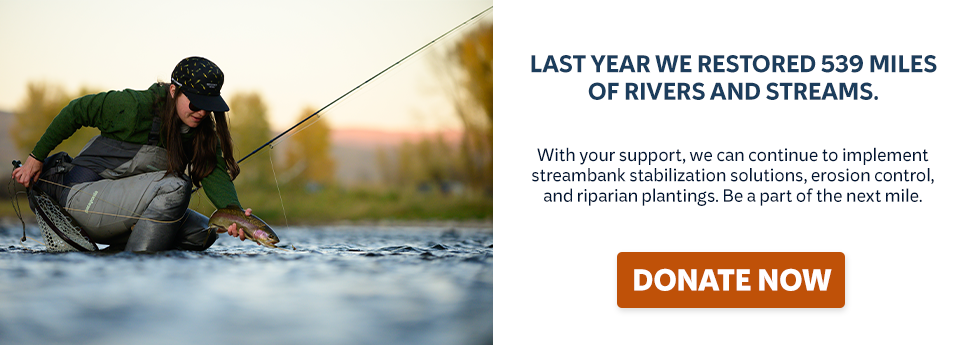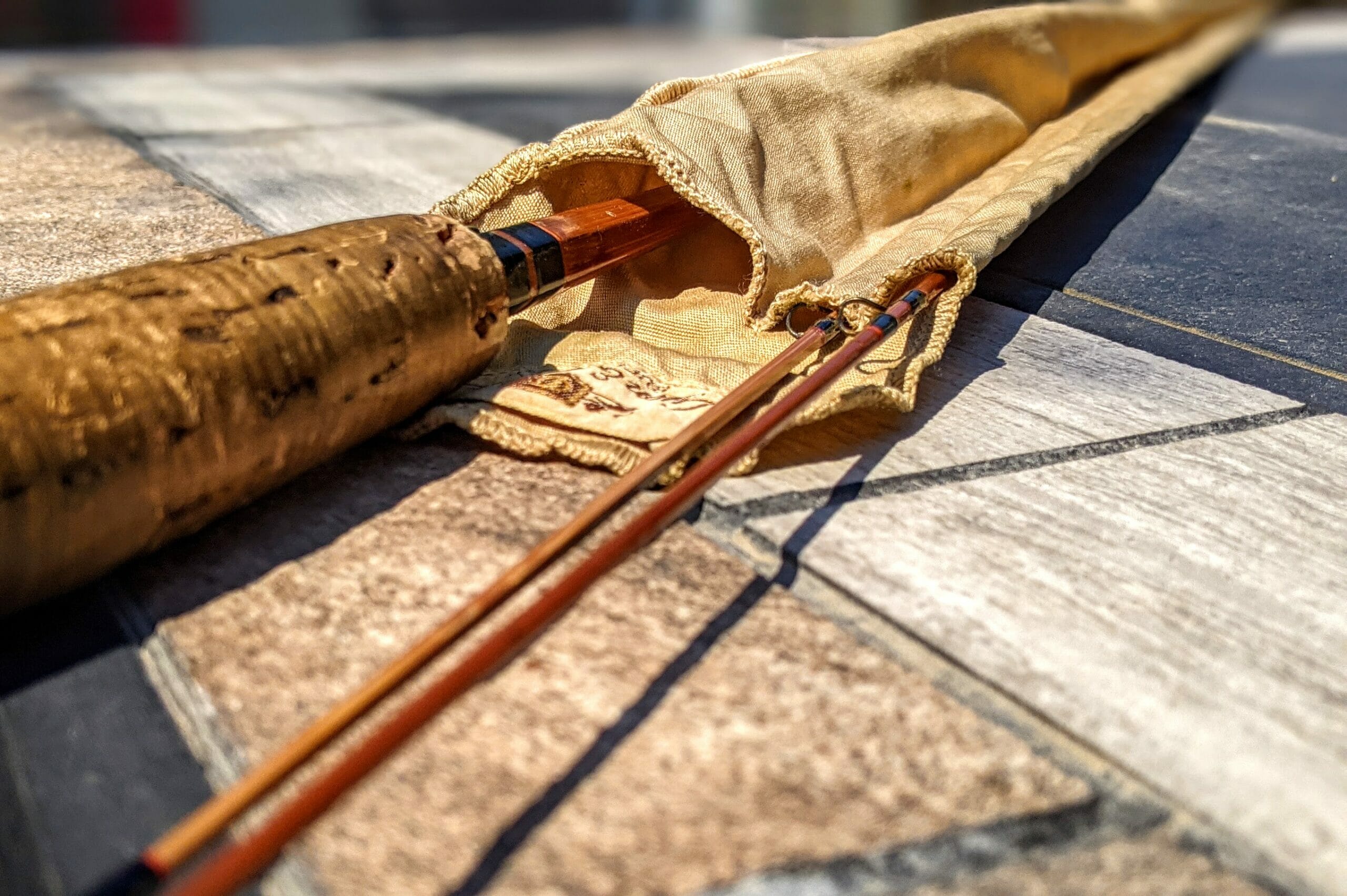“Tis a poor workman who blames his tools.”
Anonymous
By Mark Dillow
My rod tip bounced like a telegraph key with each head shake—an angry protest from a trout duped by a crane fly nymph. When the rainbow slid into the net, my knees shook with mirrored cadence. The rod was borrowed, the fly donated, and the trout a gift that scuttled the illusion I could buy my way to fly fishing excellence.
Divorce was the catalyst for my first fly rod purchase. My therapist recommended a hobby for the empty weekends without my kids. An introduction to fly fishing class at a local fly shop was just what the doctor ordered.
The following week, I returned to the shop and bought an entry level graphite rod combo set. The obsession to become a skilled fly fisher quickly followed. I devoured all manner of fly fishing media in an attempt to fast-track my success. Advertisements touting new fly rods were everywhere.
Each ad tempted me with the promise of casting perfect loops while laying out an entire fly line on command. I began adding new fly rods to my collection when I could afford it and often when I couldn’t. Each time my skills plateaued, new gear seemed to offer the solution. The dents in my credit card proved it.
Arriving at the farm, I began rigging up my name-brand rod. Rusty appeared to have no fly fishing gear, just the large suitcase that could have doubled as a fallout shelter. He placed the case on the tailgate, popped the latches and lifted Pandora’s lid.
My intervention began with an opportunity to fish some private water for trout. I was one of two guests invited to the farm that day. I met our host in a parking lot, and loaded my “best of show” gear into his truck. Soon we were joined by a Jerry Garcia doppelganger in overalls, carrying a vintage suitcase. Rusty introduced himself, heaved the suitcase into the bed of the truck, and called shotgun.
Arriving at the farm, I began rigging up my name-brand rod. Rusty appeared to have no fly fishing gear, just the large suitcase that could have doubled as a fallout shelter. He placed the case on the tailgate, popped the latches and lifted Pandora’s lid.
It was completely stuffed with split cane fly rods.
American violin maker Samuel Phillipe is credited with developing the first split cane fly rod in 1845. For nearly 100 years, split cane was the material of choice for fly rods until fiberglass was introduced after World War II. The ease of manufacture and lower cost allowed fiberglass to overtake the fly rod market. Graphite rods were introduced in 1973, and soon replaced fiberglass as the dominant fly rod material in the commercial market.
My fast-action graphite rod was from a premium brand, backed by a slick marketing campaign. Thus in my estimation, it was superior to split cane. Cane is too expensive, I reasoned, and I didn’t want to be labeled as a pretentious tweed-wearing purist. Still, they were handsome. Some were a deep flamed mahogany color, others were honey-hued.
Rusty rigged up several rods and laid them across the truck’s tool box. Paired with vintage click-and-pawl reels, they completed a traditional look.
“It y’all want to fish any of these rods, just grab one and go… I can’t fish them all anyway, ” Rusty drawled. Rusty, it turns out, builds split cane rods.
My biggest fear was that I would break a rod, requiring a second mortgage to pay for it. Rusty seemed unconcerned, so I grabbed one of the hand-crafted rods and headed to the water. Perhaps his beard and ponytail were a disguise to deflect suspicion about his affluence.
After a few casts to get a feel for the rod, I laid out a “too beautiful for me” roll cast that was rewarded with a chunky trout. Despite the large size of the fish, the cane rod absorbed all the fight the rainbow could generate, and I quickly brought it to hand. A grin crept across my face. I pulled my hat low, afraid Rusty would see it. Rod envy began to well up in me, and I began to pray that the Tenth Commandment forbidding covetousness was listed last because it was a misdemeanor.
The rods were delightful to cast, but I wouldn’t entertain the thought of owning one. It was like walking the aisles of a classic car show, and finding a ’68 Z28 Camaro that was looking for a home. Scared of the price tag and equally afraid of my inability to stop obsessing about it, I slammed the door on that rabbit hole.
If the pandemic taught us anything, it is that life is precious and fleeting. Perhaps it was the COVID lockdown or the recent loss of my father that underscored the brevity of life and drew my mind back to that day on the farm. Either way, I decided to check a split cane rod off my bucket list, and emailed Rusty.
“Do you have any suggestions for a cane rod for hopper-dropper fishing, maybe in the 3-4 weight range?”
The response came the same day; a recommendation for a Paul Young Perfectionist model with a Mesquite reel seat, which spoke to my Texan heart. Shockingly, the price was about the same as my original graphite rod and reel combo.
When the rod arrived, I attached it to a vintage Pflueger Medalist reel inherited from my father. When the wildflowers bloom the rod will accompany me to Texas Hill Country streams to chase Guadalupe bass and to Colorado cutthroat streams this fall.
Owning the latest gear has its advantages, but it isn’t a short cut to proficiency. Hand me the finest rod out there and I can still show you an expensive tailing loop. There is no substitute for practice, time on the water, and advice gleaned from others. Those experiences weave the tapestry of our fly fishing souls—memories that persist long after gear specs fade.
Odin’s words to Thor concerning his hammer Mjölnir ring true: “That hammer was to help you control your power; to focus it. It was never your source of strength.”
Odin just might have a tweed cap in his closet.
Mark Dillow is the Texas representative on the Trout Unlimited’s National Leadership Council.



